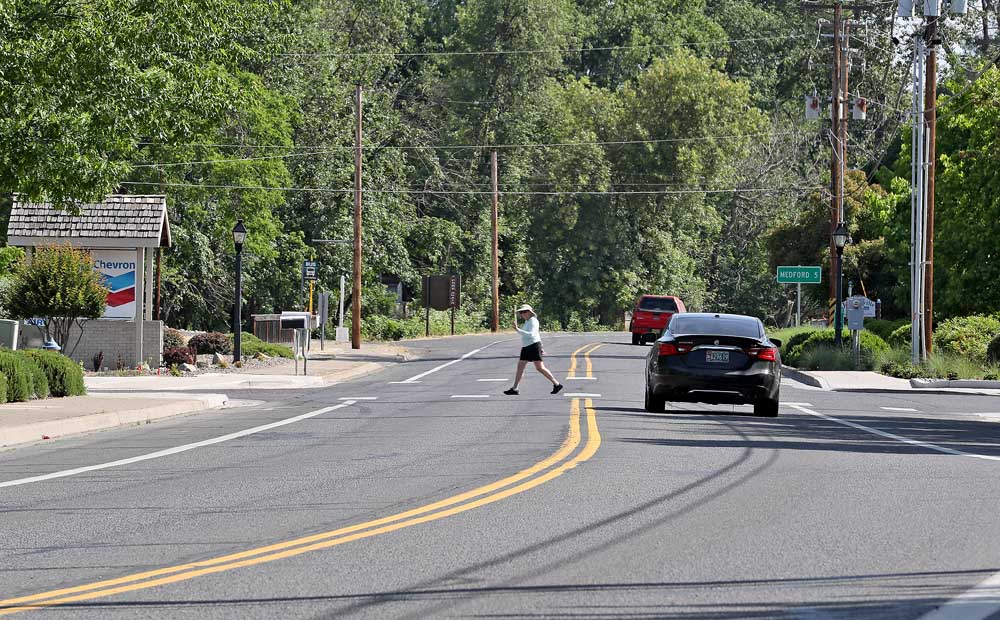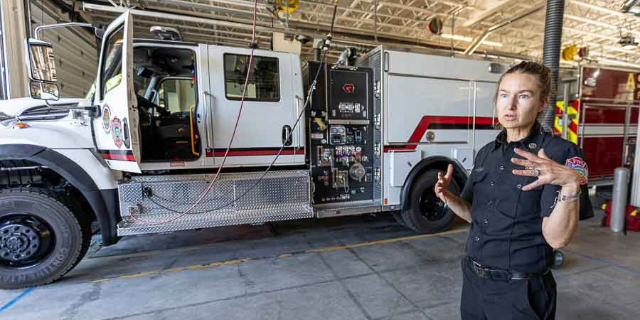‘Enough is enough’: Jacksonville residents call for action on speeding
Published 1:00 pm Monday, June 5, 2023

- A pedestrian crosses Highway 238 in Jacksonville on Monday. A petition calling for the City Council, police department and other city staff, if necessary, to create and implement an action plan to address drivers speeding through town gathered more than 375 signatures by the end of May.
Concerns about speeding and traffic safety in Jacksonville have led to the formation of Citizens for a Safer Jacksonville, which has already conducted a petition drive and held a town hall meeting.
“At a February council meeting, I just stood up during the public session and said, ‘Enough is enough. We need to do something before somebody gets killed,'” said group organizer Cindy Rasmussen, recalling how the effort started. She formed a small committee that has carried on the work.
About 45 to 50 people attended the group’s May 24 town hall, said Rasmussen. Among those were Mayor Donna Bowen, police Chief Dave Towe, City Administrator Jeff Alvis and three members of the City Council.
“It was an extremely productive and positive interaction between the city leadership and the concerned citizens. I think we have made the point. There are enough people here worried about these issues,” said Sid Rasmussen.
“We had a very profitable meeting with the Citizen for a Safer Jacksonville. It was the first of several meetings we will have with them,” said Bowen.
A petition calling for the City Council, police department and other city staff, if necessary, to create and implement an action plan to address drivers speeding through town gathered more than 375 signatures by the end of May, when the organization stopped the effort after the positive response at the town hall meeting.
“We have these main throughfares through town that serve residents and tourists and commercial trucks,” said Bowen. “People are usually in a hurry, and they sometimes don’t pay attention to traffic rules.”
The City Council, administration and police have been working to put measures in place to slow traffic. Radar signs that read and show vehicle speeds, along with increased patrols, are part of that effort over the last year.
Several areas and issues stand out to the group.
Through traffic is using side streets to cut through town, said Rasmussen. That includes people using South Oregon Street as a way to and from the Applegate, and G Street off Fifth Street that people use to travel to North Oregon Street.
“We do want to see better signage at two crucial crosswalks (on Fifth Street), one by the Chevron Station and one by Pioneer Village,” said Rasmussen. Older residents who live in that area use the crosswalks.
Rasmussen had owned a house on South Third Street since 2006. The route is a major feeder for traffic coming from locations in the hills south of town. She’d like to see something painted on the road to alert drivers to slow as they come down the hill.
“I think we can do a lot better, and we aren’t asking the city to come up with tens of thousands of dollars,” said Rasmussen.
The committee would also like see one speed throughout Jacksonville, perhaps 20 mph. On some streets such as North Fifth and California, a state through route, traffic speeds changes from 20 to 30, then 25, then 30 again.
“It is somewhat confusing if they are coming in off of West Main,” said Rasmussen.
The city has four radar units that display how fast drivers are traveling. Two of the units are permanently installed on California Street east of Fifth Street where they alert traffic from South State Road. Those units are solar powered.
The other units can be moved to 10 locations around town where special brackets on speed limit signposts allow them to be attached, Towe said. Public Works crews handle the deployment and maintenance of the units, which are battery powered. He has crews move the units to new locations every couple weeks.
Another two solar-powered, permanent units are expected to arrive shortly and will be installed on North Oregon Street, the police chief said. The city has had the mobile units for about five years, but the permanent ones have been in place for just over eight months.
Data on the impact the radar signs are having on traffic citation numbers will likely be analyzed at some point, Towe said.
Rasmussen said she hopes a plan can be developed and presented to the council during July.
“One of the issues is it’s not just the city involved, but things come down from the state level and the county level. We have a lot of rules that come into play,” said Bowen. “As soon as things can happen, they will.”






